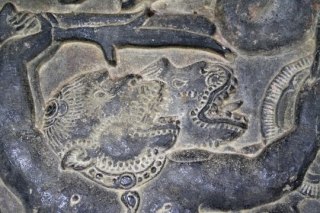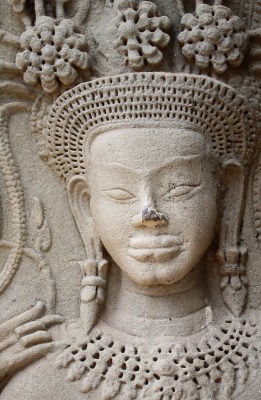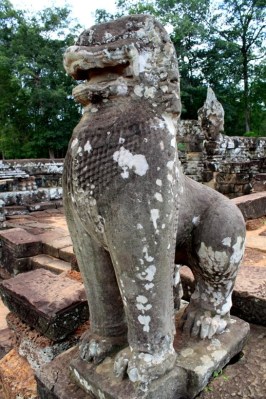On your bicycle taxi, in heavy traffic, while smoking a cigarette: That’s Phnom Penh style.
Month: May 2010
Eating lotus
It must have been lotus season in Cambodia because people were selling them everywhere as snacks. These women were hawking them outside our bus at the Cambodia-Vietnam border.
To eat them, you have to rip open the fibrous flower head.
Then you peel off the seed’s little green jacket. You’re left with a pure-white rounded cylinder that looks like a little pill or maybe an earplug. They have a slightly foam-like texture, like a mushroom but crunchier, and a mild planty taste like cucumber.
It wasn’t my favorite snack ever (I think that would still be the glorious curry puff), but it was fun to try, given the importance of the lotus to Asian culture and religion — and the number of lotus statues, bas-reliefs and paintings we’ve seen over the last few weeks.
The Killing Fields
Warning: disturbing images!
Going to from the ancient splendor of Angkor Wat to the modern horrors of the Khmer Rouge in two days is a dizzying experience. I’m not sure I’d recommend doing it that fast. But I definitely recommend the Killing Fields memorial site, which does an admirably unflinching job of telling a terrible story.
The trail points out the areas where trucks stopped to unload frightened, blindfolded prisoners. It takes you to the mass graves where their bodies lie. It describes the awful ways in which people died.
The matter-of-fact tone encourages you to put yourself in the place of those terrified prisoners … and also in the place of the murderous guards, who after all were human too. Some probably needed only the slightest encouragement to become executioners, while others were persuaded to kill after being threatened with death themselves. What would I do in their shoes?
The image you may already know from the Killing Fields is the skulls. They’re housed in a clear-sided memorial stupa where visitors can see them up close. They’re alike, of course, but each a little different, and they say more than a thousand pages in a thousand books.
From the Killing Fields we went to S21, the prison where people were held and tortured before being transferred for execution. Here it was the photographs of the victims that spoke loudest.
Who were these people? Who would they have become?
Less is more: The Siem Reap-Phnom Penh bus
The ticket from Siem Reap to Phnom Penh was a great deal even by Southeast Asian bus standards: $4.50 for a 6-hour ride. But it followed that unwritten bus rule of less-is-more: pay less money, get more noise.
First were the music videos, which were pretty fun. Some guys in the back started playing their radio at the same time, but our hero, the bus captain, strode down the aisle and told them to knock it off. After that came a Jet Li action movie, overdubbed into Khmer by two men with husky voices. About an hour into the show, the picture froze. Then the movie commenced again from the beginning, but with the soundtrack turned off and pop music blaring instead. After a few minutes, all attempts at movie-watching were abandoned and there was a period of blessed silence.
After dinner we were treated to a stunning sunset.
We optimistically put our headphones on and started listening to a podcast. But it was not to be. As darkness gathered, 90 minutes away from Phnom Penh, the bus driver put the radio on over the loudspeakers. I got all caught up on my Cambodian news, but I’m sad to say I didn’t understand a word of it.
Ta Prohm: The rhythms of rubble
The last temple we visited at the Angkor Wat complex was Ta Prohm, which has been kept in a semi-natural state to show how the temples looked before they were rehabilitated.
The rhythms of rubble compete with, and sometimes seem to complete, the rhythms of order and beauty.
And roots add their own architecture to carved rock.
Bayon: Tower of faces
One thing I didn’t know before I went there: Angkor Wat refers only to the central temple of the whole temple complex. As far as anyone knows, Angkor Wat itself has been in continuous use since it was built in the 12th century. Surrounding it are numerous other temples which were abandoned and later restored.
While Angkor Wat was built as a Hindu temple, Bayon temple has Buddhist origins. It rises up as a wall of 216 eerily serene faces. On every tower, a face looks out in each of the four directions.
Peek around any corner and you’ll be confronted by that wispy all-knowing smile. Some say the face is modeled after the bodhisattva Lokesvara; some say it is the face of the king who built the temple, Jayavarman VII. Others say it’s both.
The inner chambers are like a maze, having been built and rebuilt over the centuries to suit different kings. Little altars are scattered inside and out, where you can light a joss stick and make a small donation.
All around the outskirts of the building are little extra bits of temple, some of which make a nice dog-sized shelter on a blazing hot day.
Angkor Wat!
Angkor Wat presents a challenge to the blogger: How to describe the indescribable?
How to even begin? There are the soaring towers, of course.
I also loved the long, graceful terraces flanked with columns.
A series of bas reliefs stretches the whole length of the terraces, bringing to life, among other tales, the battle between Hanuman’s monkey army and that of the demon king Ravana.
On a more spiritual plane are the apsaras, celestial nymphs who smile from corners and columns in nearly every chamber.
My favorite, though – and I guess it’s no big surprise, cat lover that I am – was the lions. They may be corroded, with crumbling faces, but they still have powerful haunches that look coiled and ready to spring.
Next I’ll blog about some of the other temples in the complex. But I repeat, you just can’t capture Angkor Wat in a few words or photos. It is steeped in history and radiant with a dozen different kinds of magic. If you can find a way to get there, go. I don’t see how you could regret it.
Junk food purveyor of the week: 7-11
When I was a kid in Northern Virginia, there were 7-11 convenience stores everywhere. Over time their numbers dwindled. Now I know where they all went: Thailand.
In Bangkok especially, you can hardly walk a block without passing a 7-11. While this may seem excessive, it’s a sensible business strategy, because that’s about how far you can walk in the 100-degree heat before you want another cold drink.
Among 7-11’s many culinary offerings is the completely-unrefrigerated Shredded Pork Sandwich. I had my first SPS one day in Chiang Mai when I was really hungry, and I thought it was the greatest sandwich ever: pork salad sandwiched between cheap white bread with a couple of slices of pork sausage, and heavy slatherings of what seemed like some kind of yellow jam.
On closer inspection, the SPS proved to be made of pretty cheap and appalling materials. What I thought was pork salad was just floss, the highly-processed dried meat product that is also much-loved in Jakarta. The “jam” was margarine, but it must have sugar added to it because it’s distinctly sweet.
Despite its obvious crappiness, I still have a certain love for the SPS. There’s just something great about porky-sweet-salty flavors (think bacon and maple syrup), especially if you’ve been pork-deprived for four years.
Exhibit B is something I initially found horrifying: the Corn Pie. I think corn is okay, but I’m a little baffled by the Southeast Asian corn craze. I don’t mind the cups of it sold as mall treats, and even the corn-and-ice-cream combo. But something about a pie full of corn disgusts me.
That being said, this was more tolerable than I expected. There isn’t too much corn, and it’s accompanied by a pleasantly distracting cream-cheese-like substance. I finished my half, so it must not have been too bad.
Karaoke on the go
The ghosts of Ban Chiang
We didn’t do a lot of touristy stuff in Udon Thani, but we did make it out to one remarkable place: the Ban Chiang archeological site, about an hour west of downtown.
The people of Ban Chiang produced distinctive red-patterned ceramics. In fact, it was the pots working their way to the surface, like flags of an underground nation, that alerted a grad student to the presence of an ancient settlement in the late 1960s.
The people of Ban Chiang scattered pots over the bodies as part of their burial ritual. The earliest graves are believed to date back to 2100 BC. They suggest that Southeast Asia, previously thought to be a bit sluggish at developing Bronze Age tools, actually reached that landmark at a pretty respectable pace.
Afterward we walked around the little town with our heads full of bones. Lots of Ban Chiang houses are on stilts, making them look a bit like Maine or North Carolina beach houses, which added to the pleasant jumble of continents and millennia in my brain.
All the manhole covers in town are painted with patterns from the ancient pottery, which is a nice touch.
Lunch was a bowl of vegetable soup with wide, fried noodles at the bottom. It wasn’t spicy, but the accompanying jar of chopped chilis in vinegar certainly was!






































